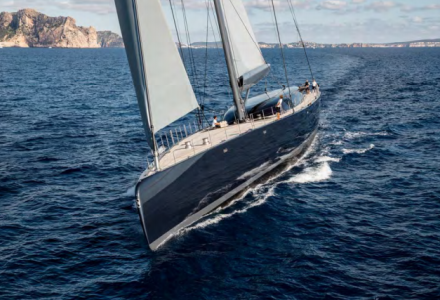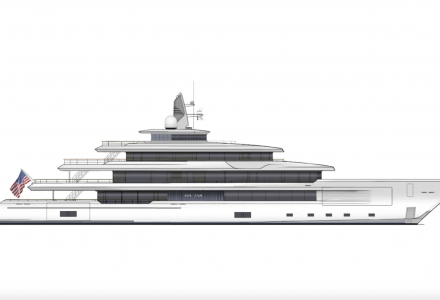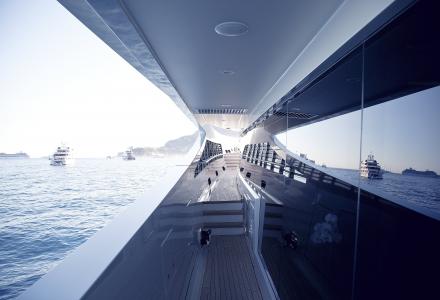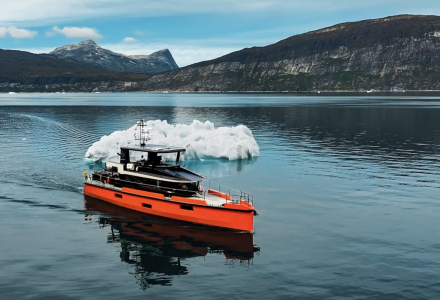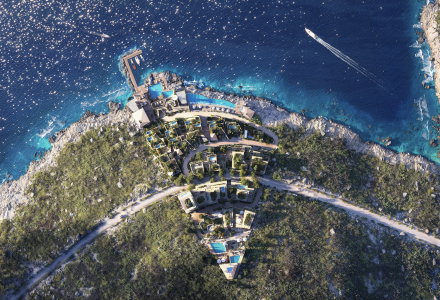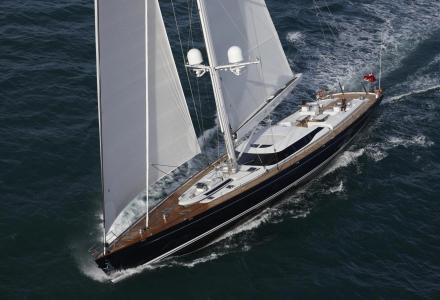Once Ngoni has completed her busy summer season in the Mediterranean, the Dutch shipyard has released the details about the sailing yacht built in 2017 to the late Ed Dubois innovative design.

First introduced at the 2014 Monaco Yacht Show as The Beast, the 58-meter Royal Huisman yacht conveys a powerful message once summarized by her owner in the following words:
The yacht’s exotic new name Ngoni, in turn, refers to the people of eastern Africa and their peculiar language, and thus, implies the unique character of the sailboat.
“This is some yacht, inspired by an owner looking for the next new, new thing – a dream project for a designer,” confessed the British naval architect Ed Dubois, who managed to develop the yacht’s concept before he passed away in March 2016, although he never saw his brainchild’s completion.
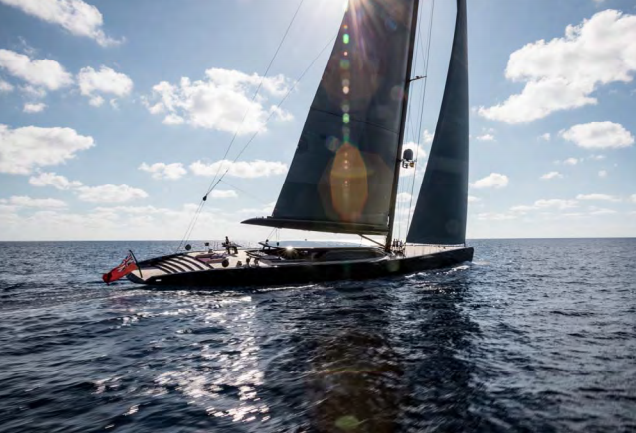
Accordingly, he created Ngoni’s signature reverse sheer and then finessed the hull profile, so that aft of the superstructure this reversed sheer transformed to concave sheer, adding an attractive styling touch that, on the functional side, enhanced cockpit visibility. What’s more, further tests confirmed that such shape of the sheer held the vital key to the structural stiffness of the hull, delivering 12% more strength and load resistance than conventional sheer made from the same materials.
With her towering carbon fiber Rondal mast – notably one of the world’s largest one-piece spar ever built - carrying a square head mainsail by North Sails, the yacht features a full air-draft of 75 meters. Performance wise, Ngoni reaches a top speed of 17.5 knots.
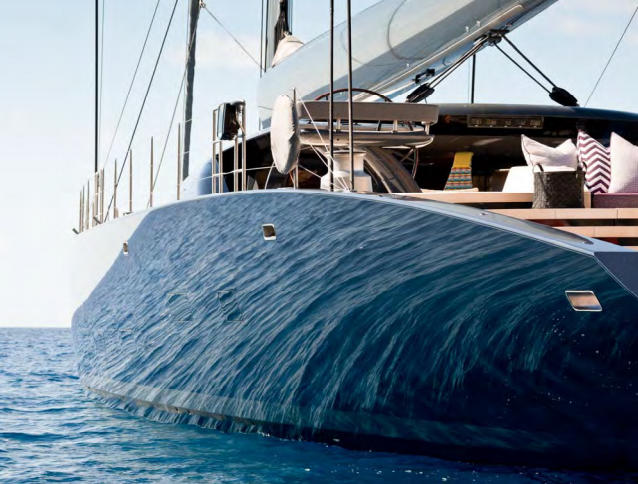
The dramatic black of the hull interplays with the topsides finished by the owner’s team in a bespoke metallic topcoat named “Claire de Lune”. The construction is punctuated by large rectangular portholes, a sea-level gym door, fold-out side boarding platform, two submarine anchors and retractable thrusters.

An experienced owner, who likes to helm, he insisted on steering that would be light, yet firm and responsive. The wheel had to give him the true feel of the boat under sail. Such a request could only be met by a high aspect-ratio rudder and a manual system without power assistance, which, taking into account the size of the sail area, presented a major challenge for engineers. The ergonomic helm stations are located aft of the cockpit area, ensuring excellent visibility for the helmsman. A carbon fiber bimini can be set up over the helms to provide shade if needed.
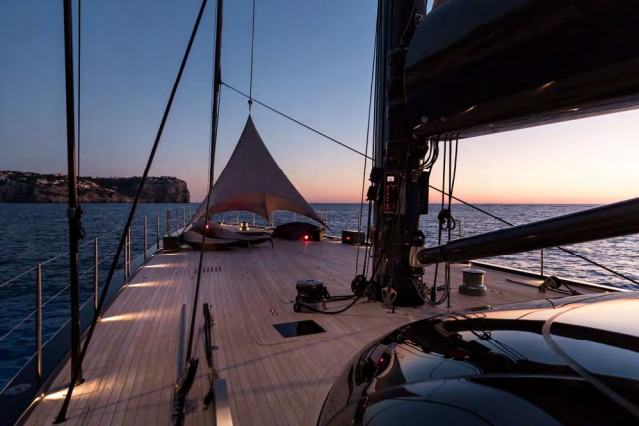
The expansive teak foredeck shelters giant flush hatches with continuous, uninterrupted planking to conceal a large tender, a crane, spa pool, sail locker and cooled waste locker.

The sculptured superstructure is constructed from double-curved molded glass. Inside, it features an informal seating to port, a dining to starboard and a navigation station forward. Glass sliding doors open to offer a barrier-less transition from the cockpit to deckhouse salon. Electrically operated sliding glass wind breakers are there to guarantee the perfect environment under any weather conditions.
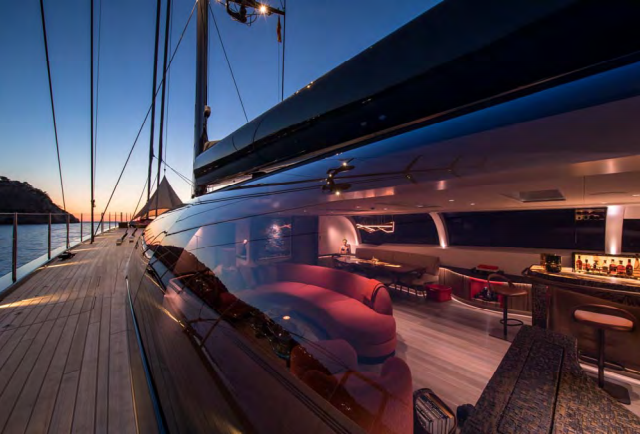
Owners’ and guest accommodation is accessed via a curving staircase from the deck house to the guest lobby area.

The boat’s interior conceived by London-based designers Rick Baker and Paul Morgan follows the owner’s straightforward brief: “Don’t design a traditional yacht interior.” Her overall scheme challenges the tradition with vibrant colors and flowing curves.
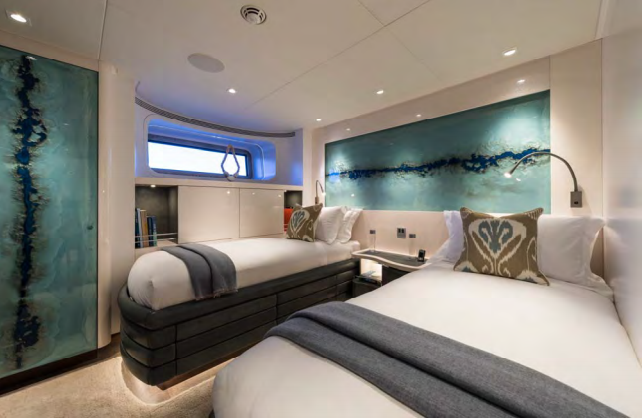
The layout includes two double guest cabins with en-suite bathrooms, both high quality exotic veneers, marbles and resin finishes. Natural light comes through large rectangular ports. The owners’ suite, aft, comprises a full-beam stateroom with built-in furniture, twin doors to an enormous bathroom, a spacious study with its own bathroom and a vast gym with an opening hull port in the topsides.
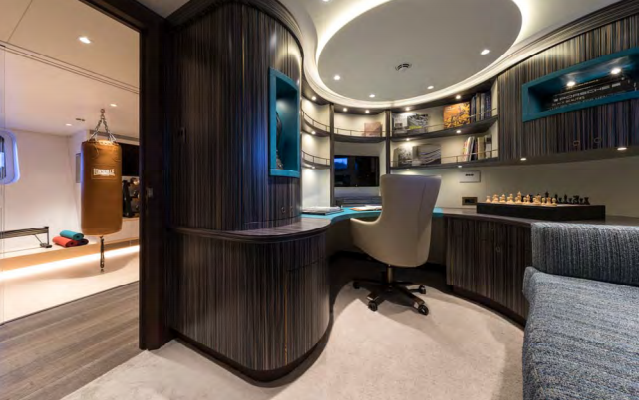
The comfortable crew quarters were designed in accordance with Large Commercial Yacht Code (LY3), providing accommodation for up to nine crew in six cabins with access to the engine control room.

First introduced at the 2014 Monaco Yacht Show as The Beast, the 58-meter Royal Huisman yacht conveys a powerful message once summarized by her owner in the following words:
“Build me a beast. Don’t build me a sheep in wolf’s clothing. This has to be an edgy and innovative weapon, fast and furious.”
The yacht’s exotic new name Ngoni, in turn, refers to the people of eastern Africa and their peculiar language, and thus, implies the unique character of the sailboat.
“This is some yacht, inspired by an owner looking for the next new, new thing – a dream project for a designer,” confessed the British naval architect Ed Dubois, who managed to develop the yacht’s concept before he passed away in March 2016, although he never saw his brainchild’s completion.

Accordingly, he created Ngoni’s signature reverse sheer and then finessed the hull profile, so that aft of the superstructure this reversed sheer transformed to concave sheer, adding an attractive styling touch that, on the functional side, enhanced cockpit visibility. What’s more, further tests confirmed that such shape of the sheer held the vital key to the structural stiffness of the hull, delivering 12% more strength and load resistance than conventional sheer made from the same materials.
With her towering carbon fiber Rondal mast – notably one of the world’s largest one-piece spar ever built - carrying a square head mainsail by North Sails, the yacht features a full air-draft of 75 meters. Performance wise, Ngoni reaches a top speed of 17.5 knots.

The dramatic black of the hull interplays with the topsides finished by the owner’s team in a bespoke metallic topcoat named “Claire de Lune”. The construction is punctuated by large rectangular portholes, a sea-level gym door, fold-out side boarding platform, two submarine anchors and retractable thrusters.

An experienced owner, who likes to helm, he insisted on steering that would be light, yet firm and responsive. The wheel had to give him the true feel of the boat under sail. Such a request could only be met by a high aspect-ratio rudder and a manual system without power assistance, which, taking into account the size of the sail area, presented a major challenge for engineers. The ergonomic helm stations are located aft of the cockpit area, ensuring excellent visibility for the helmsman. A carbon fiber bimini can be set up over the helms to provide shade if needed.

The expansive teak foredeck shelters giant flush hatches with continuous, uninterrupted planking to conceal a large tender, a crane, spa pool, sail locker and cooled waste locker.

The sculptured superstructure is constructed from double-curved molded glass. Inside, it features an informal seating to port, a dining to starboard and a navigation station forward. Glass sliding doors open to offer a barrier-less transition from the cockpit to deckhouse salon. Electrically operated sliding glass wind breakers are there to guarantee the perfect environment under any weather conditions.

Owners’ and guest accommodation is accessed via a curving staircase from the deck house to the guest lobby area.

The boat’s interior conceived by London-based designers Rick Baker and Paul Morgan follows the owner’s straightforward brief: “Don’t design a traditional yacht interior.” Her overall scheme challenges the tradition with vibrant colors and flowing curves.

The layout includes two double guest cabins with en-suite bathrooms, both high quality exotic veneers, marbles and resin finishes. Natural light comes through large rectangular ports. The owners’ suite, aft, comprises a full-beam stateroom with built-in furniture, twin doors to an enormous bathroom, a spacious study with its own bathroom and a vast gym with an opening hull port in the topsides.

The comfortable crew quarters were designed in accordance with Large Commercial Yacht Code (LY3), providing accommodation for up to nine crew in six cabins with access to the engine control room.
